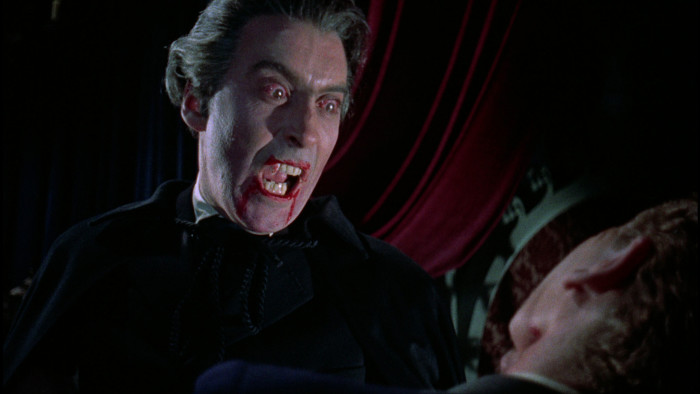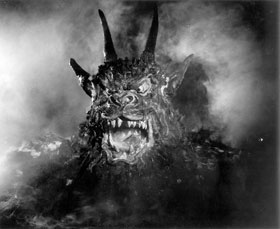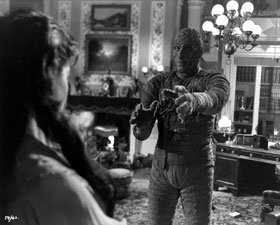‘Gothic: the Dark Heart of Film’

Roula Khalaf, Editor of the FT, selects her favourite stories in this weekly newsletter.
At this point in the summer, even the casual attendee of the outdoor screening is drooping like bog pimpernel on a sand dune at the prospect of another showing of Dirty Dancing in the local park. But arise ye (nearly) undead. A massive cross-media BFI season entitled Gothic: The Dark Heart of Film is launched this week with three titles from the golden age of British horror projected in the forecourt of the British Museum: Jacques Tourneur’s Night of the Demon (1957), and the Hammer classics Dracula (1958) and The Mummy (1959.)
The digitally remastered Demon, loosely based on Casting the Runes by MR James, is partly set at the museum itself. A smiling but maleficent cult leader lays a mortal curse on a brave unbeliever played by American actor Dana Andrews. The sceptical hero is hexed with runes drawn on a slither of parchment passed to him in the museum’s Reading Room while codgery academics turn pages under the queasy glow of Bakelite lamps. In another scene, Andrews walks through the museum forecourt, his shoulders set bravely against a depressing October fog, Edward Scaife’s noir-shadowed cinematography making the museums’ columns loom pea-soup-filthy and enormous.
The demon that appears twice in the movie (apparently knitted out of old dog hair) might have been added at the last moment on the insistence of a producer with his eye on American B-movie audience money, but the fog shrouding the museum could only be real, and could only be British.
Some other British films released in 1957: Carry On Admiral, The Barretts of Wimpole Street, The Admirable Crichton. And in the US: Attack of the Crab Monsters, An Affair to Remember, Jailhouse Rock. I know where I would rather have been.

But when Hammer put out its first production The Curse of Frankenstein later that year, it happily hauled British film into an era of irresistibly succulent and trashy stage-blood hysteria (and sex), with devils on black-winged horses trampling over the knockers of screeching brunettes.
What a tremendous aesthetic those early Hammer films had. The flabbergasting use of scarlet and pea-green. The thrifty reworking of the sets at the homely Bray Studios from scene to scene and movie to movie. The Wagnerian soundtracks and theatre-of-the-absurd razzmatazz of the openings – Dracula premiered at the Gaumont in Haymarket with an enormous hoarding of the vampire dripping neon blood on to a female neck as plump and moon-pale as an Edwardian schoolgirl’s.
For Hammer, Christopher Lee and Peter Cushing gave some of the greatest performances we have – grave and graceful and entirely uncynical. Never has a man worn a cape with more unbothered panache than Lee as the count, moving up stuccoed castle stairs like a preoccupied and unsmiling surgical consultant sweeping from one ward to another. One moment he is entirely suave and urbane, the next a savage sex-god slowly closing the bedroom door while a cat-eyed woman in terrible polyester rends the hair snaking down her back.

Then there is Peter Cushing, his fine cheek bones so crushable and tender, his beautiful eyes convincingly harrowed by years of Egyptian studies or nights removing grit from the brain of a hanged convict. “Ah, there’s the turtle dove in the background,” Cushing once pointed out quietly to a BBC soundman in 1972 when recording a programme about his love of birds, and then went on to tell the story of chasing a turnstone for a mile along a beach to help remove a painful fishing hook from its tongue. This the actor who had recently completed The House That Dripped Blood and Incense for the Damned.
But it is the peculiar cosiness of the early Hammer films that makes them unique. Their sympathetic instinct towards their various monsters and mummies and werewolves. That nice secret feeling you get of being in a distant movie castle in a distant movie-version eastern Europe, a mythical place from a picture book evoking a warmth that horror stories so often depend on: a warmth that a child would recognise snuggled tight in bed listening to one being told.
It’s not mere incompetence or foolishly low budgets that give Hammer its particular look – it’s actually a good artistic decision. In a Germanic hostelry littered with garlic flowers (“Are you a stranger here in Klausenberg?”) or overseeing the mummification of the Princess Ananka by 20 Namibian slaves, even the very young viewer instinctively knows that this is in fact lunchtime in Berkshire.
If Night of the Demon has a more dankly sinister kind of heightened excitement – opening with a flickering shot of Stonehenge and a hallucinatory drive down a Somerset lane darkened by in-leaning leafless trees – there is to all three films screening this weekend a lovely seam of peculiarly British melancholy.
‘Monster Weekend’, August 29-31, British Museum, London
‘Gothic: The Dark Heart of Film’ is at the BFI Southbank and across the UK from October 2013 to January 2014
Comments